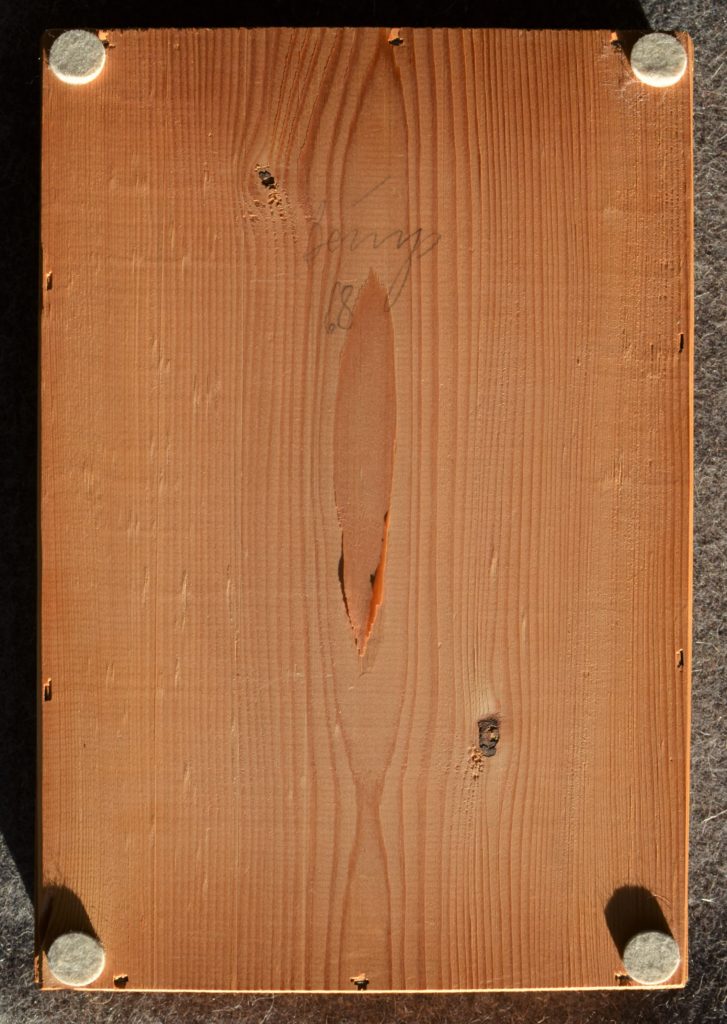My first contact with Beuys came as a teenager through my very art-interested stepfather Ernst Oldemeyer. He reported on various visits to the Documenta in Kassel, the third way between communism and capitalism, and showed me the wooden box he had acquired at Documenta IV in 1968. It is the multiple „Intuitionsbox“, of which about 12,000 were made for Beuys and all of which the artist pencilled and signed.
It seemed very strange to me as a teenager that a small wooden box with pencil marks carved into it and the word „Intuition“ should be a valuable work of art. But Beuys didn’t intend it as such, but rather as a simple utilitarian object that everyone could use themselves. In Ernst’s case, it stood on the work table and served as storage for writing utensils.
What could have motivated Joseph Beuys to produce and distribute these boxes? Making money does not fit as a motive, because initially it was offered by mail order for 8 DM per piece.
Even today, its value is around 500 euros, a rather small amount for a work by such a famous artist as Beuys.
Perhaps a look at a philosophical publication by my stepfather will take us further. I quote from his book „Alltagsästhetisierung“ (Everyday Aesthetisation), published in 2008 by Königshausen & Neumann: „For all the desirable preservation of its aesthetic autonomy, art would do well not to stop at a self-conscious aestheticism, but to be intent on influencing the struggle for the extra-aesthetic problems of its present with ephemeral and ascetically applied means. Only if art does not make its reception too easy, but rather makes demands on the consciousness-raising of its audience, can it hope to retain an essential function in the cultural process in the future.“
In the very next chapter of the book, some of the actions of the artist Beuys are mentioned as examples of the use of such ephemeral, aesthetically not necessarily appealing and not easily consumable artistic means of design.
The box also gives us such an impression visually.
In an excerpt from Gerster’s „Do it yourself Art“, a text that Ernst also had in the intuition box, it says: „Art consists of thinking, and its products are waste products of this process, says Beuys. He understands the Intuition Box as an objectification of his memento. Its indication consists of two lines: symbols for two kinds of thinking. A line with a marked beginning and end stands for „rational thinking in quantities“. A straight line beginning at the right edge, which weakens and loses itself to the left, stands for „intuitive thinking in qualities.“
The word „intuition“ is written into the wood again, so this kind of thinking seemed to be particularly important to Beuys. So the owners of the boxes should be encouraged to think intuitively.
We could spend hours discussing what intuition is, but in the context of my contribution I would like to go into some biographical experiences of Joseph Beuys and Ernst Oldemeyer, whose years of birth are only 7 years apart. It is possible that these experiences from their time as adolescents and young adults respectively contributed to their particularly intense preoccupation with the development of mental models for the society in which they lived.
When Beuys was 23 years old, the plane in which he was working as a soldier and radio operator during the Second World War crashed. The pilot did not survive the accident. Beuys escapes with a few broken bones and a crash trauma and probably experiences the death of his work colleague at first hand.
At the age of about 16, Ernst was called up for the so-called „Volkssturm“ (People’s Storm) during the total war and had to help build an airfield near Kahla in Thuringia, where thousands of forced labourers were also deployed. Their food situation is catastrophic and some of them come running to the Hitler Youth, staggering with exhaustion, begging for a piece of bread. When the group leader of the Hitler Youth, who is barely older than them and has lost a leg in the war, sees this, he hits the forced labourers with his crutches and drives them away.
After the collapse of the Nazi dictatorship, further atrocities come to light, with which the two young men Ernst Oldemeyer and Joseph Beuys are also confronted as contemporary personalities.
Through their work, both Beuys as a visual artist and my stepfather Ernst as a philosopher sought a new society in which what they had experienced as young men could under no circumstances be repeated. Even if the world has not become a better place in principle, as Ernst stated regretfully in his old age after the rise of terrorism, both of them contributed in their own way to the fact that we as the following generation could grow up quite differently. How we develop their thoughts further is now up to us. Beuys‘ intuition box calls us to do so.

Meinen ersten Kontakt zu Beuys bekam ich als Teenager über meinen sehr kunstinteressierten Stiefvater Ernst Oldemeyer. Er berichtete von verschiedenen Besuchen der Documenta in Kassel, dem dritten Weg zwischen Kommunismus und Kapitalismus und zeigte mir das Holzkästchen, das er bei der Documenta IV 1968 erworben hatte. Es ist das Multiple „Intuitionsbox“, von denen ca. 12.000 Stück für Beuys angefertigt wurden und die der Künstler alle mit Bleistift bearbeitet und signiert hat.
Mir kam es als Jugendliche sehr komisch vor, dass ein Holzkästchen mit eingeritzten Bleistiftstrichen und dem Wort „Intuition“ ein wertvolles Kunstwerk sein sollte. Aber als solches war es von Beuys auch gar nicht gedacht, sondern als schlichter Gebrauchsgegenstand, dessen Nutzung jeder selbst bestimmen konnte. Bei Ernst stand es auf dem Arbeitstisch und diente als Aufbewahrung für Schreibutensilien.
Was könnte Joseph Beuys zur Herstellung und Verbreitung dieser Kästen bewogen haben? Geld verdienen passt nicht als Motiv, denn anfänglich wurde es für 8 DM pro Stück im Versandhandel angeboten.
Selbst heute liegt sein Wert bei etwa 500 Euro, ein ziemlich geringer Betrag für ein Werk eines so berühmten Künstlers wie Beuys.
Vielleicht bringt uns ein Blick in eine philosophische Publikation meines Stiefvaters weiter. Ich zitiere aus seinem Buch „Alltagsästhetisierung“, das 2008 im Verlag Königshausen & Neumann erschienen ist: „Bei aller wünschenswerten Wahrung ihrer ästhetischen Autonomie tut die Kunst gut daran, nicht bei einem selbstbefangenen Ästhetizismus stehen zu bleiben, sonder darauf bedacht zu sein, mit vergänglichen und asketisch eingesetzten Mitteln auf das Ringen um die außerästhetischen Probleme ihrer Gegenwart Einfluss zu nehmen. Nur wenn die Kunst ihre Rezeption nicht zu leicht macht, vielmehr Ansprüche an die Bewusstseinsbildung ihres Publikums stellt, kann sie hoffen, in Zukunft eine wesentliche Funktion im Kulturprozess zu behalten“.
Gleich im nächsten Kapitel des Buches werden einige Aktionen des Künstlers Beuys als Beispiele für den Einsatz von solchen vergänglichen, ästhetisch nicht unbedingt ansprechenden und nicht einfach konsumierbaren künstlerischen Gestaltungsmitteln genannt.
Das Kästchen vermittelt uns optisch ebenfalls einen solchen Eindruck.
In einem Auszug aus Gersters „Do it yourself Kunst“, einem Text den Ernst ebenfalls in der Intuitions-Box liegen hatte, heißt es: „Kunst besteht aus Denken, und ihre Produkte sind Abfallprodukte dieses Prozesses, sagt Beuys. Die Intuitions-Box versteht er als Vergegenständlichung seines Mementos. Sein Hinweis besteht aus zwei Strichen: Symbole für zwei Arten Denken. Eine Strecke mit markiertem Anfang und Ende steht für „rationales Denken in Quantitäten“. Eine am rechten Rand beginnende Gerade, die nach links schwächer wird und sich verliert, steht für „intuitives Denken in Qualitäten“.
Das Wort „Intuition“ ist extra nochmal in das Holz hineingeschrieben, diese Art von Denken schien Beuys also besonders wichtig zu sein. Die Besitzer der Boxen sollen also zum intuitiven Denken angeregt werden.
Darüber was Intuition ist könnten wir stundenlang diskutieren, ich möchte im Rahmen meines Beitrags auf einige biografische Erfahrungen von Joseph Beuys und Ernst Oldemeyer eingehen, deren Geburtsjahre nur 7 Jahre auseinander liegen. Möglicherweise haben diese Erlebnisse aus ihrer Zeit als Jugendliche bzw. junge Erwachsene dazu beigetragen, sich besonders intensiv mit der Entwicklung gedanklicher Leitbilder für die Gesellschaft in der sie lebten zu beschäftigen.
Als Beuys 23 Jahre alt ist, stürzt das Flugzeug in dem er während des Zweiten Weltkriegs als Soldat und Funker arbeitet, ab. Der Pilot überlebt den Unfall nicht. Beuys kommt mit einigen Knochenbrüchen und einem Absturztrauma davon und erlebt den Tod seines Arbeitskollegen wahrscheinlich hautnah mit.
Im Alter von etwa 16 Jahren wird Ernst im Rahmen des totalen Kriegs zum sogenannten „Volkssturm“ einberufen und muss bei Kahla in Thüringen beim Bau eines Fluglatzes mithelfen, bei dem auch tausende Zwangsarbeiter eingesetzt werden. Deren Ernährungssituation ist katastrophal und einige von Ihnen kommen schwankend vor Erschöpfung zu den Hitlerjungen gelaufen und betteln um ein Stück Brot. Als der Gruppenführer der Hitlerjungen der kaum älter ist als sie und durch den Krieg ein Bein verloren hat das sieht, schlägt er mit seinen Krücken nach den Zwangsarbeitern und vertreibt sie.
Nach dem Zusammenbruch der Nazi-Diktatur kommen weitere Greueltaten ans Licht, mit denen sich auch die beiden jungen Männer Ernst Oldemeyer und Joseph Beuys als Zeitzeugen konfrontiert sehen.
Sowohl Beuys als bildender Künstler auch mein Stiefvater Ernst als Philosoph suchten durch ihre Arbeit nach einer neuen Gesellschaft, in der sich das was sie als junge Männer erlebt hatten auf keinen Fall mehr wiederholen könnte. Auch wenn die Welt prinzipiell nicht besser geworden ist, wie Ernst im Alter nach dem aufkommen des Terrorismus bedauernd feststellte, so haben beide auf ihre Weise dazu beigetragen, dass wir als nachfolgende Generation ganz anders groß werden konnten. Wie wir ihre Gedanken weiterentwickeln, liegt nun bei uns. Beuys´ Intuitionsbox ruft uns dazu auf.





